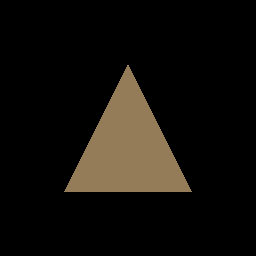# Creating gifs
Sometimes you've created a nice simulation/animation, and you want to show it off. While you can record a video, that might be a bit overkill to break out your video recording if you just want something to post on Twitter. That's where what GIF (opens new window)s are for.
Also, GIF is pronounced GHIF, not JIF as JIF is not only peanut butter (opens new window), it is also a different image format (opens new window).
# How are we making the GIF?
We're going to create a function using the gif crate (opens new window) to encode the actual image.
fn save_gif(path: &str, frames: &mut Vec<Vec<u8>>, speed: i32, size: u16) -> Result<(), failure::Error> {
use gif::{Frame, Encoder, Repeat, SetParameter};
let mut image = std::fs::File::create(path)?;
let mut encoder = Encoder::new(&mut image, size, size, &[])?;
encoder.set(Repeat::Infinite)?;
for mut frame in frames {
encoder.write_frame(&Frame::from_rgba_speed(size, size, &mut frame, speed))?;
}
Ok(())
}
All we need to use this code is the frames of the GIF, how fast it should run, and the size of the GIF (you could use width and height separately, but I didn't).
# How do we make the frames?
If you checked out the windowless showcase, you'll know that we render directly to a wgpu::Texture. We'll create a texture to render to and a buffer to copy the output to.
// create a texture to render to
let texture_size = 256u32;
let rt_desc = wgpu::TextureDescriptor {
size: wgpu::Extent3d {
width: texture_size,
height: texture_size,
depth_or_array_layers: 1,
},
mip_level_count: 1,
sample_count: 1,
dimension: wgpu::TextureDimension::D2,
format: wgpu::TextureFormat::Rgba8UnormSrgb,
usage: wgpu::TextureUsages::COPY_SRC
| wgpu::TextureUsages::RENDER_ATTACHMENT,
label: None,
};
let render_target = framework::Texture::from_descriptor(&device, rt_desc);
// wgpu requires texture -> buffer copies to be aligned using
// wgpu::COPY_BYTES_PER_ROW_ALIGNMENT. Because of this we'll
// need to save both the padded_bytes_per_row as well as the
// unpadded_bytes_per_row
let pixel_size = mem::size_of::<[u8;4]>() as u32;
let align = wgpu::COPY_BYTES_PER_ROW_ALIGNMENT;
let unpadded_bytes_per_row = pixel_size * texture_size;
let padding = (align - unpadded_bytes_per_row % align) % align;
let padded_bytes_per_row = unpadded_bytes_per_row + padding;
// create a buffer to copy the texture to so we can get the data
let buffer_size = (padded_bytes_per_row * texture_size) as wgpu::BufferAddress;
let buffer_desc = wgpu::BufferDescriptor {
size: buffer_size,
usage: wgpu::BufferUsages::COPY_DST | wgpu::BufferUsages::MAP_READ,
label: Some("Output Buffer"),
mapped_at_creation: false,
};
let output_buffer = device.create_buffer(&buffer_desc);
With that, we can render a frame, and then copy that frame to a Vec<u8>.
let mut frames = Vec::new();
for c in &colors {
let mut encoder = device.create_command_encoder(&wgpu::CommandEncoderDescriptor {
label: None,
});
let mut rpass = encoder.begin_render_pass(&wgpu::RenderPassDescriptor {
label: Some("GIF Pass"),
color_attachments: &[
wgpu::RenderPassColorAttachment {
view: &render_target.view,
resolve_target: None,
ops: wgpu::Operations {
load: wgpu::LoadOp::Clear(
wgpu::Color {
r: c[0],
g: c[1],
b: c[2],
a: 1.0,
}
),
store: wgpu::StoreOp::Store,
},
}
],
depth_stencil_attachment: None,
});
rpass.set_pipeline(&render_pipeline);
rpass.draw(0..3, 0..1);
drop(rpass);
encoder.copy_texture_to_buffer(
wgpu::TexelCopyTextureInfo {
texture: &render_target.texture,
mip_level: 0,
origin: wgpu::Origin3d::ZERO,
},
wgpu::TexelCopyBufferInfo {
buffer: &output_buffer,
layout: wgpu::TexelCopyBufferLayout {
offset: 0,
bytes_per_row: padded_bytes_per_row,
rows_per_image: texture_size,
}
},
render_target.desc.size
);
queue.submit(std::iter::once(encoder.finish()));
// Create the map request
let buffer_slice = output_buffer.slice(..);
let request = buffer_slice.map_async(wgpu::MapMode::Read);
// wait for the GPU to finish
device.poll(wgpu::PollType::Wait)?;
let result = request.await;
match result {
Ok(()) => {
let padded_data = buffer_slice.get_mapped_range();
let data = padded_data
.chunks(padded_bytes_per_row as _)
.map(|chunk| { &chunk[..unpadded_bytes_per_row as _]})
.flatten()
.map(|x| { *x })
.collect::<Vec<_>>();
drop(padded_data);
output_buffer.unmap();
frames.push(data);
}
_ => { eprintln!("Something went wrong") }
}
}
Once that's done we can pass our frames into save_gif().
save_gif("output.gif", &mut frames, 1, texture_size as u16).unwrap();
That's the gist of it. We can improve things using a texture array, and sending the draw commands all at once, but this gets the idea across. With the shader I wrote we get the following GIF.
